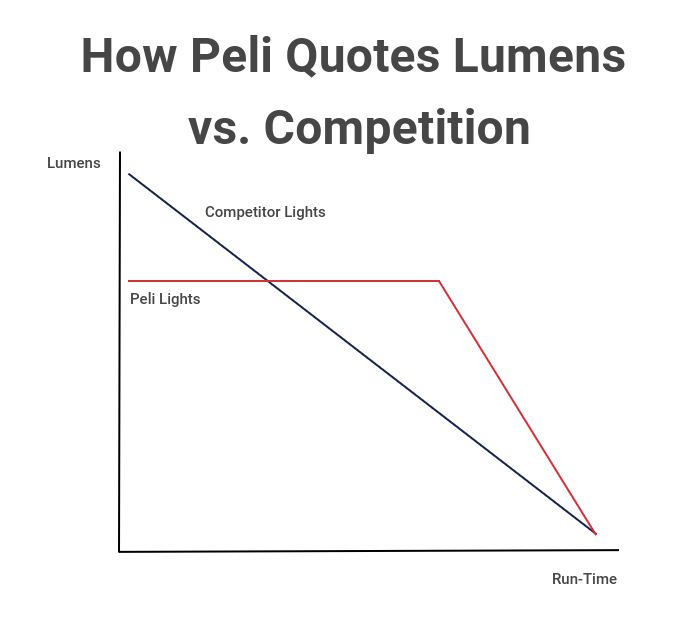
Lumens are not the only feature to consider when evaluating the quality of a flashlight Leave a comment
Understand why lumens are not the only characteristic to consider when evaluating the quality of a lamp.
Definition of a lumen
A lumen is a unit of measurement that quantifies the total luminous flux of light visible to the human eye from a lamp or light source. This means that the higher the number of lumens in a torch, the brighter it is.
Lumens are the unit of measurement used to determine the light output of a lamp according to ANSI standards. To learn more about ANSI standards, please read the Proteclight article "ANSI Standards".
Why are lumens not the only characteristic to consider when evaluating the quality of a flashlight?
Some lighting manufacturers seek to produce the brightest possible lamp to market it as better than the competition.
But lumens are not the only criteria to consider when evaluating the quality of a lamp.
Let's take the example of a car and its horsepower. Would you consider a Toyota with more horsepower than a BMW to be a better car just because it has more horsepower? Not necessarily, because the power of your car will not be the only criteria you will take into account when buying it.
The same goes for lumens. While lumens are one of the most telling features to the consumer, there are many other factors to consider when evaluating the quality of one light over another. It is the combination of features such as runtime, beam distance, shock resistance and more that really determines the quality of a lamp. A single feature does not determine if it is a quality lamp.

The knowledge of the manufacturer is also an element to take into account
The Peli Products brand is known for being the world leader in waterproof protective cases. As a result, Peli™ flashlight bodies are made from the same materials as the cases to withstand impacts, drops, chemicals and other extreme conditions. Peli™ flashlights are designed to last a lifetime, which is not necessarily the case with other brands.
It is also important to consider how lumens are measured by brands. In fact, some flashlight brands give the maximum lumen level, which is the lumen level that is reached immediately after turning on the flashlight at its highest brightness setting. While this may seem logical, the problem is that this brightness level can only be maintained for a short time. While the brightness level of a lamp may be 1,000 lumens initially, that level will be significantly lower within a few minutes of turning on the lamp. This is not the case with Peli™ flashlights. The number of lumens listed for Peli™ flashlights is the number of lumens that can be sustained over a long period of operation. Admittedly, it may be low, but it will be true.

The ANSI standard for testing is also a consideration when choosing your flashlight. ANSI has not only established the characteristics to be measured to determine the quality of a lamp, but they also regulate the testing. ANSI states that to meet their standard, lumens must be measured 10 seconds after the flashlight has been turned on. As for runtime, it is measured until 10% of the battery life is reached. Peli™ flashlights all adhere to the ANSI standard.
Are lumens as important for Atex lamps?
The short answer is yes. But lumens for an Atex lamp are still much less important than other features. Indeed, when you want to buy an Atex certified explosion proof lamp, it is important to consider what can cause an explosion: a spark that occurs when the lamp is turned on or heat from the lamp.
Logically, the higher the lumen level, the higher the temperature, and therefore the greater the risk of an accidental explosion in a hazardous area. Thus, Atex lamps always have lower lumen levels than other flashlights, such as tactical lamps or industrial lamps.
Nevertheless, as with all other lamps, there are multiple features and benefits to consider when evaluating lighting choices beyond lumens. However, when evaluating Atex lamps, the most important thing to consider is whether the manufacturer of the explosion-proof lamp actually obtains true certifications in accordance with the European Atex Directive. Everything else should be of secondary importance, especially the lumens.
Why choose a Peli™ flashlight?
Lumens are important, but there are many other aspects and features you should consider when determining which flashlight is right for you.
Peli Products ensures 100% compliance with all regulations and standards.
Materials, weight, dimensions, light output, beam range, number of LEDs, battery life, accessories, Peli™ thinks its products through every detail to fit any type of use while ensuring efficiency and user protection.
In addition, Peli™ lighting is designed to stand the test of time and Peli™ flashlights are covered by the Peli™ lifetime warranty.

Share your opinion!